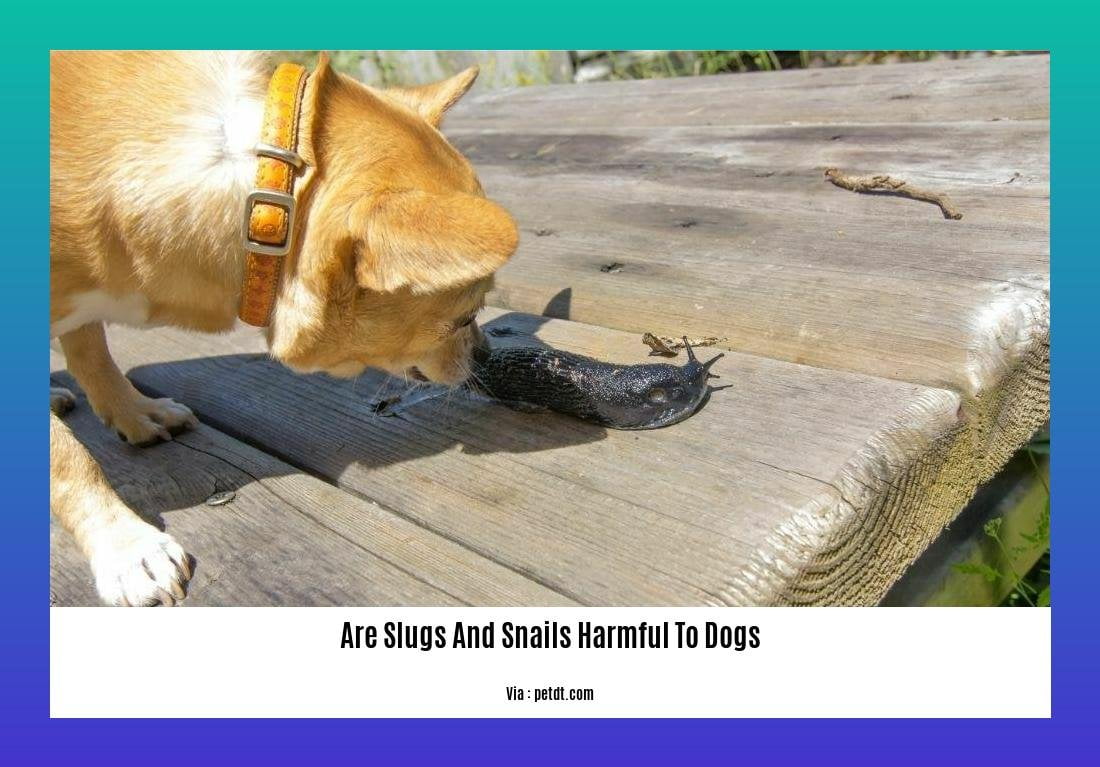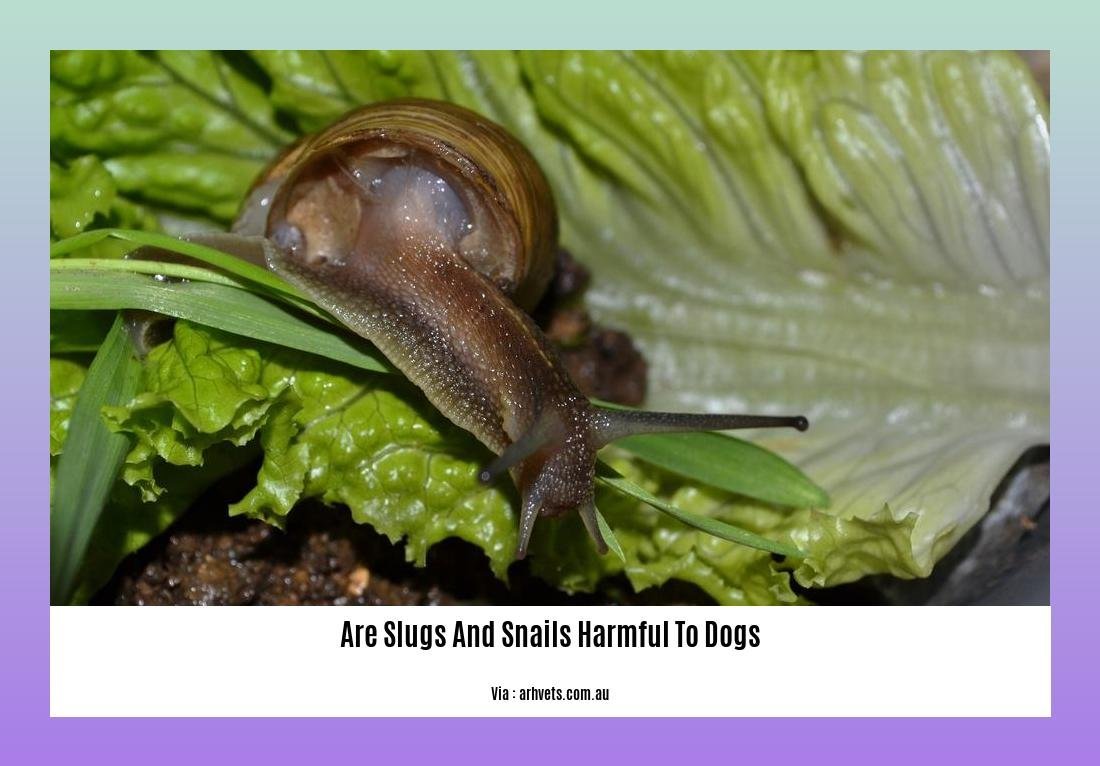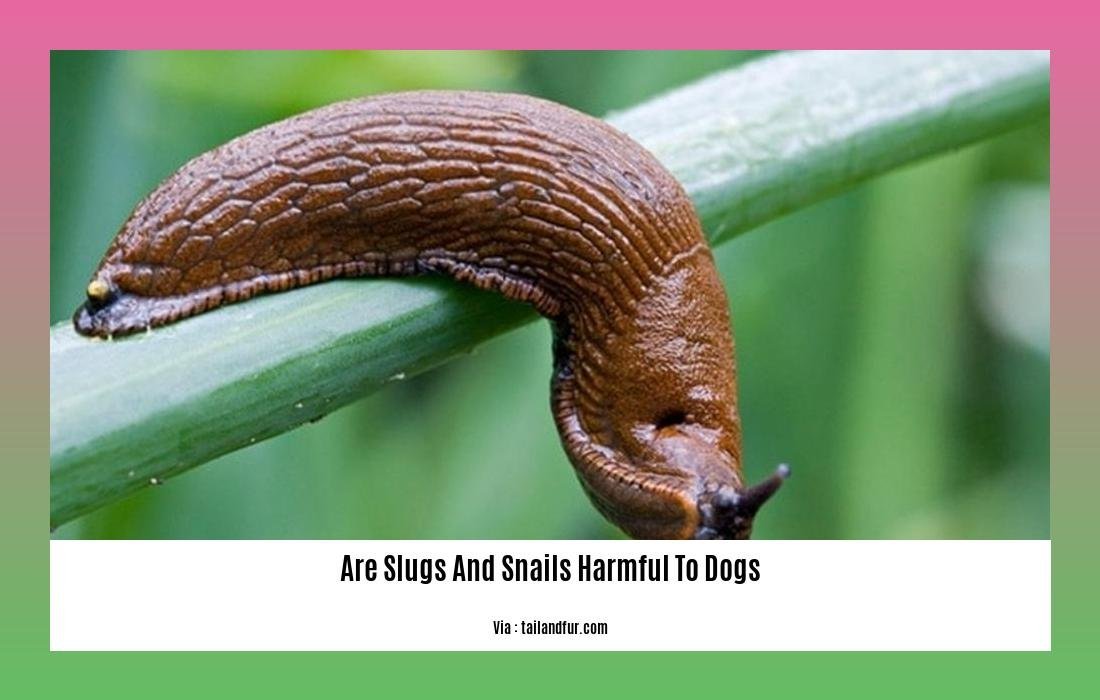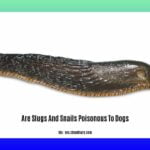Are Slugs and Snails Harmful to Dogs? Understanding the Potential Dangers and How to Keep Your Canine Companion Safe
As pet owners, we do everything we can to keep our beloved dogs safe and healthy. However, there are certain unforeseen dangers that may lurk in our own backyards – slugs and snails. While these slimy creatures may seem harmless, they can pose a significant threat to our canine companions. As a seasoned veterinarian specializing in pet toxicology, I have witnessed firsthand the risks and consequences associated with slug and snail exposure. In this article, we will delve into the potential harm these gastropods can cause to dogs and provide practical tips on how to safeguard your furry friend from these dangers.
Key Takeaways:
- Slugs themselves are not toxic or poisonous to dogs, but they can carry a parasite that causes lungworms in dogs.
- Ingesting slugs or licking them can increase the risk of dogs getting infected with the lungworm parasite, which can lead to serious health problems including coughing, bleeding, breathing issues, and even death.
- Some slugs and snails can transmit Rat lungworms to dogs, which can be fatal without medication.
- Swallowing a slug can result in coughing, excessive bleeding, blood clotting, breathing problems, and weight loss in dogs, and it can be particularly dangerous for older dogs or puppies with weak immune systems.
- To prevent slug infestation, it is recommended to remove slug habitats and use slug pellets or natural alternatives.
- Dogs should be monitored and treated for potential lungworm infections if they have been exposed to slugs or snails.
Are Slugs and Snails Harmful to Dogs? Understanding the Potential Dangers and How to Keep Your Canine Companion Safe

Do you ever find yourself worried about the safety of your furry friend during your outdoor adventures? As a seasoned veterinarian with expertise in pet toxicology, I understand your concerns about the potential harm that slugs and snails can pose to dogs. While these slimy creatures may not seem threatening, it’s important to be aware of the risks they can pose to your canine companion.
The Potential Dangers of Slugs and Snails
Contrary to popular belief, slugs and snails themselves are not toxic or poisonous to dogs. However, they can carry a parasite called lungworm, which can cause serious health issues for our four-legged friends. When dogs eat or lick slugs, they can become infected with this parasite, leading to a condition known as lungworm disease.
Understanding Lungworm Disease
Lungworm disease in dogs can result in various symptoms, including coughing, bleeding, breathing difficulties, and, in severe cases, even death. The lungworm parasite resides in the respiratory system of dogs and can cause significant damage if left untreated. It’s important to note that while most garden slugs do not contain toxins that are harmful to dogs when ingested, they do increase the risk of lungworm transmission.
Preventing Slug and Snail Infestation
Taking preventive measures to keep slugs and snails at bay is crucial for ensuring the safety of your beloved pet. By removing slug habitats, such as damp hiding places and piles of debris, you can minimize the likelihood of encountering these creatures. Using slug pellets or natural alternatives can also help control their population. However, it’s essential to keep in mind that not all slug and snail control methods are pet-friendly, so choose products that are labeled as safe for use around animals.
Protecting Your Dog from Slug and Snail-Induced Lungworm
If you suspect that your dog has come into contact with slugs or snails or has ingested them, it’s essential to monitor their health closely. Look out for symptoms such as coughing, excessive bleeding, breathing problems, and weight loss. If your dog displays any of these signs, it’s crucial to seek veterinary attention promptly.
To protect your furry friend from lungworm infection, regular preventive treatments are highly recommended. These treatments, prescribed by your veterinarian, can help prevent lungworm infestation and keep your dog safe. Remember, prevention is key to ensuring the well-being of your canine companion.
Conclusion
While slugs and snails themselves may not be toxic or poisonous to dogs, the potential dangers lie in the parasites they may carry, such as lungworm. Ingesting slugs or coming into contact with their slime can lead to serious health problems for your furry friend. By taking preventative measures to control slug and snail populations and ensuring your dog receives regular veterinary care, you can keep them safe from the risks associated with these gastropods.
Sources:
1. Are Slugs Poisonous to Dogs? – pangopets.com
2. Are Slugs Poisonous to Dogs? – doggysaurus.com
Are you wondering if ramshorn snails are good for your ponds? Find out more about their benefits by clicking here: are ramshorn snails good for ponds
Keep your furry friend safe! Discover if slugs and snails are dangerous to dogs by clicking here: are slugs and snails dangerous to dogs
Toxicity can vary. Learn about the potential dangers of slugs and snails to dogs by clicking here: are slugs and snails poisonous to dogs
The Risk of Slug and Snail Bait Poisoning in Dogs

Slug and snail bait poisoning can pose a serious threat to our beloved canine companions. These common garden pests may seem harmless, but the chemicals found in many slug and snail baits can be toxic to dogs. It’s crucial for pet owners to understand the potential dangers and take preventive measures to keep their dogs safe from this type of poisoning.
Metaldehyde is the compound commonly found in most snail and slug poisons. Even small amounts of metaldehyde can have a devastating effect on dogs. Ingesting just 1 ounce of 3% metaldehyde can lead to toxicity in a 10-pound dog. This neurotoxin acts fast, and symptoms of metaldehyde poisoning usually appear within 1-4 hours. Therefore, immediate veterinary evaluation is crucial if your dog has consumed any of these baits.
The first sign of metaldehyde poisoning in pets is often vomiting. However, if left untreated, it can progress rapidly and lead to more severe symptoms. Metaldehyde poisoning can be lethal within a few hours, so timely decontamination and treatment are essential to decrease the risk of serious poisoning signs.
It’s worth noting that metaldehyde baits come in various forms, including pellets, liquid, or powder. Regardless of the form, they all pose a significant risk to dogs if ingested. It’s important to be cautious and prevent any access your dog may have to these products.
When it comes to protecting our dogs, prevention is key. Here are some key steps you can take to minimize the risk of slug and snail bait poisoning:
Secure slug and snail bait: Store slug and snail baits securely, out of reach of your dog. Be mindful of where you place them, ensuring your furry friend cannot access them, even if they explore your garden or outdoor areas.
Choose pet-safe alternatives: Consider using pet-friendly slug and snail control methods. Many eco-friendly options are available that are safe for dogs and effective in deterring these pests from your garden.
Educate yourself and pet-sitters: Ensure you and anyone who takes care of your dog are aware of the dangers of slug and snail bait and understand the importance of keeping it away from your canine companion.
Be vigilant during walks: Keep a close eye on your dog during walks, especially in outdoor areas where slugs and snails may be present. Discourage them from investigating or eating these creatures.
In conclusion, the risk of slug and snail bait poisoning in dogs is a serious concern. The metaldehyde contained in these baits is highly toxic to our four-legged friends, with ingestion leading to potentially life-threatening symptoms. By taking preventive measures and being educated about the dangers these baits pose, we can keep our dogs safe and protected from this type of poisoning.
Key Takeaways:
– Slug and snail bait poisoning can be extremely dangerous for dogs, with ingestion of metaldehyde leading to toxicity.
– Immediate veterinary evaluation is necessary if your dog has consumed slug and snail bait.
– Symptoms of metaldehyde poisoning, such as vomiting, can appear within 1-4 hours of ingestion.
– Securely store slug and snail bait out of your dog’s reach to prevent accidental ingestion.
– Consider using pet-safe alternatives for slug and snail control in your garden.
– Remain vigilant during walks to ensure your dog does not encounter or consume slugs or snails.
Sources:
1. Snail & Slug Bait – Poisonous For Pets | Preventive Vet
2. Metaldehyde Poisoning: the Dangers of Snail and Slug Bait
Signs and Symptoms of Slug and Snail Toxicity in Dogs
Slugs and snails may seem harmless, but they can pose serious risks to our canine companions. As a seasoned veterinarian specializing in pet toxicology, I’ve seen firsthand the potential harm these slimy creatures can cause to dogs. In this article, we’ll explore the signs and symptoms of slug and snail toxicity in dogs, helping you understand the dangers and keep your furry friend safe.
Identifying Slug and Snail Toxicity in Dogs
When it comes to slug and snail toxicity in dogs, there are certain signs and symptoms pet owners should be aware of. These indicators can vary depending on the specific type of poisoning, such as metaldehyde poisoning from consuming slug and snail bait. Common symptoms include:
- Heavy, labored breathing: Dogs may experience difficulty breathing and display rapid, shallow breaths.
- Coughing and bringing up blood: If your dog is coughing and has blood in their phlegm or vomit, it could be a sign of slug or snail toxicity.
- Weight loss and loss of appetite: Poisoning can lead to a decrease in appetite and unintended weight loss in dogs.
- Blindness: In some cases, dogs may suffer from vision impairment or even complete blindness.
- Vomiting and diarrhea: These gastrointestinal symptoms are commonly associated with slug and snail toxicity in dogs.
- Lethargy: Dogs affected by slug and snail toxicity may become unusually tired and lack energy.
- Seizures: Seizures can occur as a result of the toxic effects on the dog’s nervous system.
- Unexplained collapsing: Some dogs may collapse or have difficulty standing due to the effects of slug or snail poisoning.
It’s important to note that these symptoms can be indicative of various types of poisonings, including lungworm infection from ingesting slugs or snails. If you suspect your dog has been exposed to slugs, snails, or slug and snail bait, it’s crucial to seek immediate veterinary attention.
Key Takeaways:
- Slug and snail toxicity in dogs can lead to a range of symptoms, including heavy breathing, coughing with blood, weight loss, loss of appetite, blindness, vomiting and diarrhea, lethargy, seizures, and unexplained collapsing.
- If your dog consumes metaldehyde-based slug and snail bait, vomiting is usually the first sign of poisoning, necessitating immediate veterinary evaluation.
- It’s essential to monitor your dog’s health closely if they come into contact with slugs or snails, and seek veterinary attention if any symptoms of slug and snail toxicity arise.
- Preventive measures, such as removing slug habitats and using safe slug and snail control methods, can help keep your dog safe from potential dangers.
- Regular preventive treatments prescribed by a veterinarian can help protect dogs from lungworm infection transmitted by slugs and snails.
Sources:
- Wag! – “Symptoms of metaldehyde poisoning from eating slug and snail bait”
- Dog Health – “Slug and Snail Bait Poisoning Can Quickly Cause Death in Dogs”
Preventive Measures to Keep Dogs Safe from Slugs and Snails
Slugs and snails may seem harmless, but they can pose potential risks to our beloved canine companions. As a seasoned veterinarian with expertise in pet toxicology, I understand the importance of taking preventive measures to ensure the safety of dogs. In this article, I will provide valuable insights and practical tips on how to protect your dogs from the potential dangers associated with slugs and snails.
Understanding the Risks
While slugs and snails themselves are not toxic or poisonous to dogs, they can carry a parasite called lungworm. Dogs can become infected with lungworm if they eat or lick slugs, snails, or even their slime. Lungworm disease in dogs can cause symptoms such as coughing, bleeding, breathing difficulties, and even death. Therefore, it’s crucial to take proactive steps to prevent dog interaction with slugs and snails.
Preventive Measures
To keep your dogs safe from slugs and snails, consider the following preventive measures:
- Avoid Leaving Dog Toys and Water Bowls Outside Overnight: Slugs and snails can crawl on these items and leave behind infective lungworm larvae, even through their slime. Bring dog toys and water bowls indoors overnight to minimize the risk of exposure.
- Remove Slugs and Snails from Your Garden: Regularly check your garden for slugs and snails and remove them to reduce the chance of your dog coming into contact with them. This proactive step can help minimize the risk of lungworm infection.
- Be Vigilant while Walking Your Dog: Keep a close eye on your dog during walks to prevent them from eating anything that could be infected with lungworm, such as slugs, snails, or their slime. This extra vigilance can significantly reduce the risk of exposure.
- Clean Up Dog Poop Promptly: Lungworm larvae can be found in dog feces, so it is essential to promptly remove it from your yard. By practicing good hygiene and promptly disposing of dog poop, you can help prevent the spread of lungworm infection.
Choosing Safe Pest Control Methods
When it comes to controlling slugs and snails, it’s essential to prioritize the safety of your pets. Most snail and slug poisons contain a compound called metaldehyde, which is extremely poisonous to cats and dogs. Ingesting even a small amount can be toxic to dogs. Instead of relying on chemical-based pest control, consider these pet-friendly alternatives:
- Horticultural Grit: Use horticultural grit around your plants and garden beds to create a barrier that slugs and snails find difficult to cross. This method is safe for pets, children, and wildlife.
- Plant-Based Snail and Slug Gel: Opt for plant-based snail and slug gels, which are safe to use around pets, children, and wildlife. These gels help deter slugs and snails from your garden without posing a risk to your furry friends.
By choosing natural and organic pest control methods, you can ensure the safety of your pets while keeping slugs and snails at bay.
Seeking Veterinary Guidance
If your dog has accidentally eaten a slug or you suspect any potential exposure to slugs or snails, it is advisable to consult a veterinarian promptly. A veterinarian can provide proper guidance and treatment based on your dog’s specific situation.
Key Takeaways:
- Slugs and snails can carry a parasite called lungworm, which can be harmful to dogs.
- Preventive measures, such as removing slugs and snails from your garden, being vigilant during walks, and promptly cleaning up dog poop, are essential to reduce the risk of lungworm infection.
- Metaldehyde, a compound found in many snail and slug poisons, is extremely poisonous to pets. Choosing pet-friendly alternatives, such as horticultural grit and plant-based snail and slug gel, can help protect your pets from exposure.
- If you suspect any exposure or ingestion of slugs or snails, it is crucial to consult a veterinarian for appropriate guidance and treatment.
References:
[1]: Hepper. (n.d.). My Dog Ate a Slug: Here’s What to Do (Vet Approved Advice).
[2]: Preventive Vet. (n.d.). Snail & Slug Bait – Poisonous for Pets.
FAQ
Q1: Are slugs and snails toxic or poisonous to dogs?
A1: While slugs and snails themselves are not toxic or poisonous to dogs, they can carry a parasite called lungworm that can cause serious health problems in dogs if ingested.
Q2: How do dogs get infected with lungworm from slugs and snails?
A2: Dogs can get infected with lungworm by eating or licking slugs and snails that carry the lungworm larvae. The larvae can be transmitted to the dog’s body, leading to potential health issues.
Q3: What are the symptoms of lungworm infection in dogs?
A3: Symptoms of lungworm infection in dogs can include coughing, bleeding, breathing issues, weight loss, loss of appetite, blindness, vomiting, diarrhea, lethargy, seizures, and unexplained collapsing.
Q4: Can dogs die from eating slugs and snails?
A4: Ingesting slugs and snails can lead to serious health problems in dogs, and in some cases, it can be fatal, especially for older dogs or puppies with weak immune systems.
Q5: How can I protect my dog from slugs and snails?
A5: To protect your dog from slugs and snails, you can take measures such as avoiding leaving dog toys and water bowls outside overnight, removing slugs and snails from your garden, being vigilant during walks to prevent your dog from eating them, and promptly cleaning up dog poop to prevent the spread of lungworm infection.















